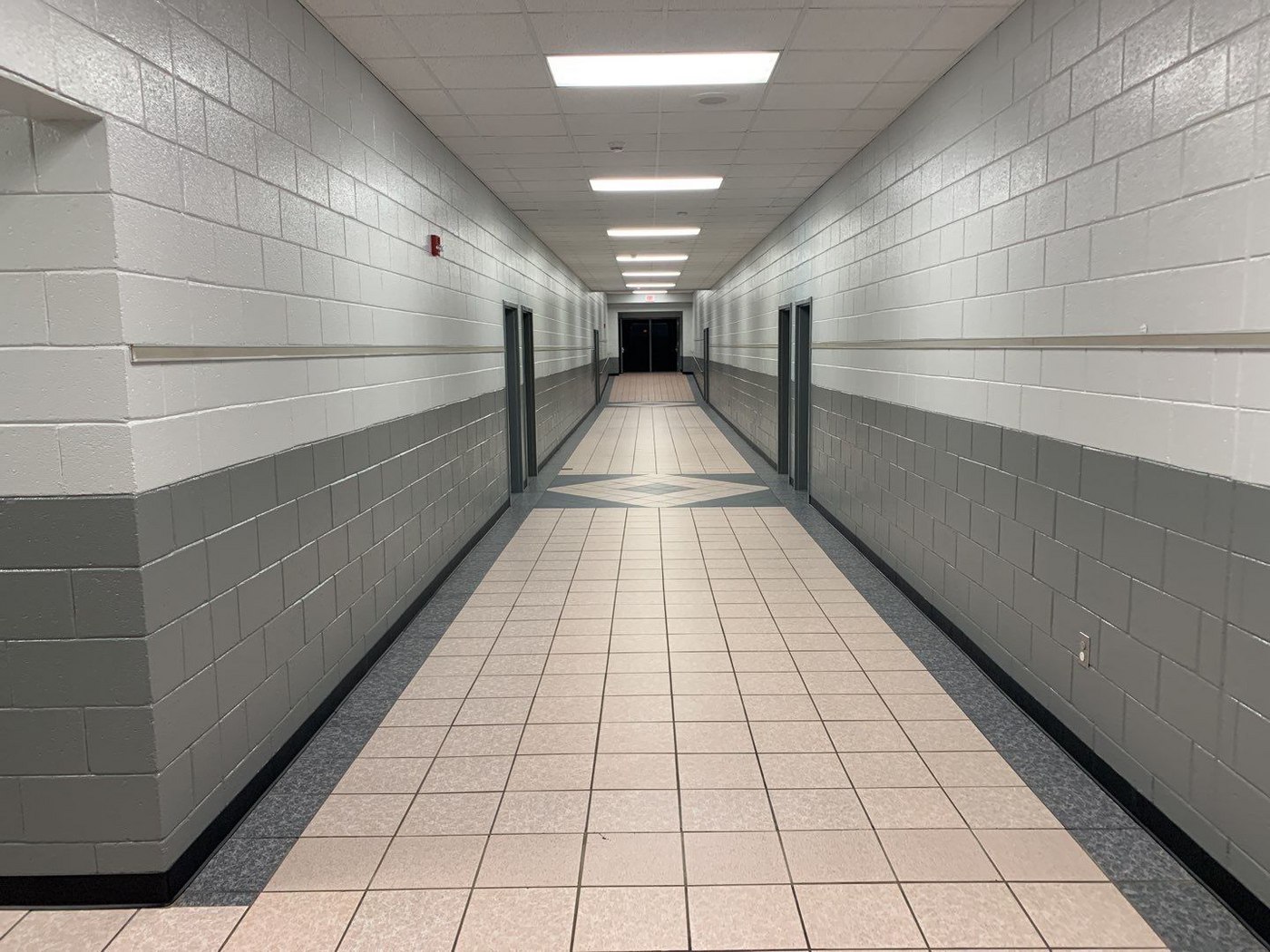posted by Custom Coatings, Inc. on February 1st, 2021
How Much Will it Cost to Paint My School?
The bells rings, and they’re off: a thousand bodies crush into hallways and common spaces, bumping walls, scraping with fingers, rubbing against every surface as they hustle from one room to the next. In the gym, basketballs pound walls and tennis shoes scuff baseboards every single period.
It happens every day, ten times a day for three-quarters of the year. No wonder your school’s hallway walls are scuffed, your school colors fading on gym and cafeteria walls. A fresh, new coat of paint would make a huge difference. But how much will that cost, and how will you know if your school painting contractor is doing all they can to ensure your surfaces will stay looking fresh and clean for as long as possible?
At Custom Coatings – your educated painting contractor – we have a few tips and checklist items you’ll want to pay attention to if you’re looking to paint and looking for a good experience with a school painting contractor.
First: How Much Will It Cost to Paint My Gym or Other High-Traffic Area?
While most painters price per square foot, you’ll find that many price per square foot of floor, not wall space. (And unless they’re painting or coating your floor, that doesn’t make much sense, does it?) Here’s an example: A hallway that’s 100’ long and 8’ wide has floor space of 800 square feet. But if the ceilings are 8’ high, that means 1,728 square feet of wall space. If the walls are 10 feet tall, that’s 2,160 square feet. See where we’re going? It’s a big difference, and can result in estimates that pale in comparison to actual costs, and cause stress all around. So, the first thing to understand about good pricing is that you should be looking at a price per square feet of actual wall space.
Here’s how we price painting work: For basic clean, prep, repair and one coat of paint, you’ll be looking at around $.45-$.65 per square foot on walls that are 10’ or less. Go higher, and the price goes up. The price of paint will affect that a bit – more expensive paint will make the price a bit more…cheap paint, a bit less.
You’ll also need to account for the hourly rate of the labor if additional work is added after the fact. A price around $45-$50/hr. per worker is pretty much industry rate.
Finally, on surfaces other than walls, like door frames, railings, base boards and ceilings, the pricing is different. Figure on somewhere around $.65-$.85 a square foot for ceilings, over a dollar a square foot for railings and base boards, and $26 or so for each door frame. More surface area or more units of a certain item, the more reasonable pricing will become. Again, there are a number of variables to take into account that your commercial painting contractor will discuss with you, but you should expect to see it laid out clearly on an estimate so there are no surprises for anyone.
Now, how can you make the painting of your educational facility the most effective, efficient, and the best experience for everyone? Here’s a few tips.
Tip 1: Choose Better Paint
There are lots of paint choices on the market, but the bottom line is better paint means longer between painting your high-traffic spaces, and that despite all the abuse they take, they’ll just look better day to day. It’s pretty easy to understand that products that are the most cleanable and the most durable aren’t the least expensive. And when you’re talking about painting a gym (for example) where balls and bats and floor hockey pucks are likely to be smacking against walls daily, you don’t want to cheap out. Facility pride is school pride.
For high traffic spaces like common areas, hallways, bathrooms and gyms, we typically recommend schools choose a high-quality water borne epoxy that comes “pre-catalyzed.” That means the paint is not solvent-based (which can cause breathing problems; see below for more), and that it’s pre-mixed, meaning our craftsmen only have to open the bucket and get going rather than spending time mixing liquids on-site. These paints are super-durable: cleanable with harsh chemicals over and over, able to be splashed on and resist damage to wall substrates, and hold up brilliantly to scuffs, stains and grime. The three major paint manufacturers we use – Sherwin Williams, PPG and Benjamin Moore – all make a high-quality commercial-grade water borne epoxy. We recommend any of them.
Our best advice though: Don’t cheap out on paint quality. To us (and any reputable school painting contractor), the installation of the paint is exactly the same whether the gallon cost $10 or $100. It’s what happens one, two or five years down the road that can be very different. Think of it this way: you can pay the bare minimum for paint, but you’ll likely be painting your facility much more often. If you go for the high quality coating, even if the up-front cost is more, you’ll come out ahead in the long run, since you won’t have to pay multiple times for labor.
Tip 2: Consider Air Quality
We find that many schools have previously been painted with older, caustic paints that produced a large amount of “off gassing” during installation – and that many school administrators’ view of painting is colored by that past experience. Teachers complained of the smell, parents worried about the air quality for students, and what should have been a rejuvenating experience for the school turns into a potential health scare and administrative hassle.
For the sake of respiratory health in crowded and closed-off spaces typical to schools such as classrooms, hallways and bathrooms, we always recommend using low-to-no-VOC paints that are much less “smelly” and cause fewer adverse reactions for teachers and students working in freshly painted spaces. VOCs are “volatile organic compounds,” essentially rogue molecules that break free of chemical surfaces and float around, eventually into the respiratory systems of humans. Newer, better quality paints shed less of these elements, making them less noticeable and less irritating, keeping teachers, students and parents more comfortable.
Tip 3: Work on YOUR Schedule
We’ve got a lot to say about this topic, but to hit the high points, it’s imperative when working with a commercial school painting contractor that you choose a partner willing to schedule on your terms, not theirs.
For us, when we work with educational systems – schools and universities – we begin project planning and scheduling in February or March of each year, way ahead of June, July and August’s summer holidays. This gives us and school administration ample time to work out a painting schedule that doesn’t interfere with classes, sports and events. It also gives everyone time to prep for work to be done and alert staff and others who might be in the buildings. We also use this time to if anything over-communicate about what’s about to happen. (You should look for a contractor willing to do the same.)
The effect of this level of planning is huge on the overall painting experience: Everyone feels heard, informed, and prepared for work to begin, meaning projects have a better chance of going smoothly and seamlessly from the start.
Tip 4: Plan to Do It Again
For high-traffic spaces that take a high volume of abuse, wear and tear, painting is never a one-and-done proposition. No matter how good the work was or how high quality the paint, surfaces will dull and get dirty over time. For this reason, we recommend setting up a repaint schedule for each facility based on its needs.
The timing depends on the work, the wear and tear, and the school; your schedule will be your own. But, to have a sense of the timing, we can say this: Many schools we work with operate with a five-year repaint cycle. Some, however, opt for something shorter – like a two-year cycle. The point there is to ensure that most-trafficked areas like doors and doorjambs and areas where water and harsh cleaning chemicals are tough on surfaces like bathrooms – get attention much more regularly.
The whole point of all of it however is to ensure your school or university facility is living up to its image as a high-quality institution of learning. No small part of that is its appearance. Paint is one important way schools telegraph their worth. A great painting contractor can help you achieve the look – and perception – your school needs to succeed.
Have additional questions? We’re here to help. Contact us at info@customcoatingsinc.com or visit our website to fill out a contact form. Want more helpful tips and information on school and university commercial painting? Check out our education series on our blog, including How to Ensure Painting on Your Schedule.




